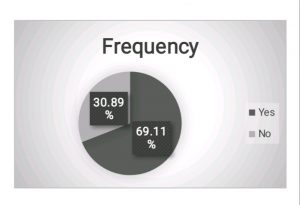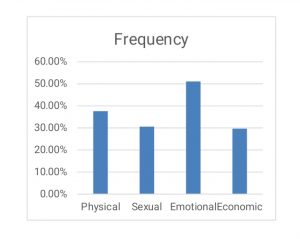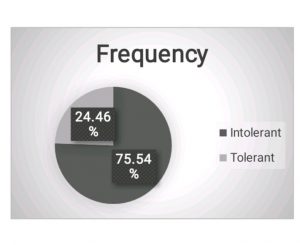ABSTRACT
BACKGROUND: Intimate Partner Violence is a global, community health problem which has a disastrous effect on the overall health victims. It is no respecter of the economic status or gender of the victim. Women are more prone to intimate partner violence than any other form of violence. The issue of Intimate Partner Violence is world-wide and the consequences are immense; aside from the woman who bears the direct impact of the violence, her children, the society to which she belongs and even the economy are indirect sufferers of this problem.
OBJECTIVES: To determine the Awareness, Prevalence and Attitude towards Intimate Partner Violence among women of child-bearing age in Epe Local Government Area.
METHODOLOGY: This was a cross-sectional study among 350 women of child-bearing age in Epe Local Government area. Interview based questionnaires were administered to collect data. Analysis was carried out using Epi-info 2007 statistical software. Chi-square and T-tests was used to test for associations between categorical and continuous variables respectively.
RESULTS: All the respondents were aware of intimate partner violence. The highest responses were “Hitting with a hand or object”, “slapping”, “sexual acts without consent”, “name calling” and “public humiliation” were the most identified examples of IPV (94.80%, 94.19%, 94.50%, 93.58% and 92.97% respectively).
The overall prevalence of IPV in this study was 69.11%.

Fig. 1. Overall Prevalence of IPV among the respondents. The portion “Yes” represents the respondents who have experienced one or more forms of the IPV in this study (69.11%), while the portion “No” represents the proportion of respondents who have not experienced any of the forms of IPV listed in this study (30.89%)The prevalence of physical violence was 37.61%, sexual violence was 30.58%, emotional violence was 51.07% and economic violence was 29.66%.

Fig 2: The overall Prevalence of Physical (37.61%), Sexual (30.58%), Emotional (51.07%) and Economic (29.66%) forms of violence respectively.
The prevalence of IPV was seen to be significantly associated with some personal factors of both the respondents and their spouses/partners such as the age of the woman and her partner/spouse, religion, number of children, cohabitation drugs and alcohol use, multiple sexual partners. Economic factors such as women earning more than their partners/spouses and community factors such as the belief that women are subject to men, and community acceptance of IPV.
Overall, one-quarter (24.46%) of the respondents were tolerant towards IPV. The prevalence of IPV was significantly associated with socio-demographic variables of the respondents, their spouses/partners and some personal, economy and community factors.

Fig. 3: Overall Attitude of the respondents towards IPV. Majority of the respondents (75.54%) were Intolerant towards IPV and 24.46% were tolerant towards IPV.
CONCLUSION: Although the awareness of IPV among the respondents was high and majority of them were intolerant to IPV, the overall prevalence of IPV was still high in the community. The prevalence of IPV was seen to be significantly associated with some personal factors of both the women and their sexual partners, economic and community factors
Some proffered recommendations include:
- There should be stricter illicit drug control measures as it is implicated in the prevalence of almost all forms of violence.
- Community leaders and prominent members of the society should lead campaigns on violence. These campaigns should be directed especially towards at risk populations such as unemployed men, older men, polygamous men etc.
- There should be more police involvement in issues of intimate partner violence as it is a recognized crime.
Author: Dr. Oddie-Okeke Chiemelie C (College of Medicine, University of Lagos)




Discussion2 Comments
I am going to go ahead and bookmark this content for my sister for the study project for class. This is a attractive website by the way. Where did you get the template for this website?
Appreciate writing this. I love the online world because you can study something new every day. I’ll share this with my friends, thank you!